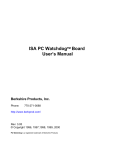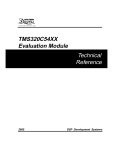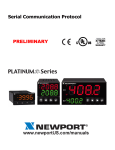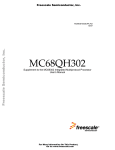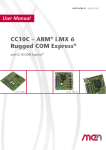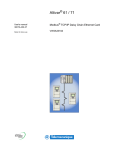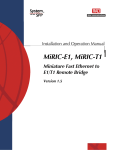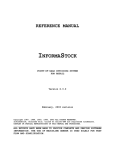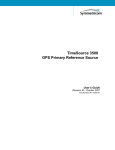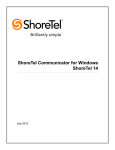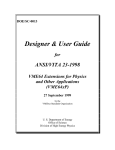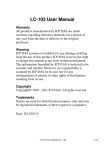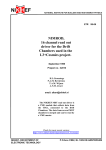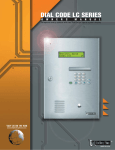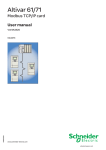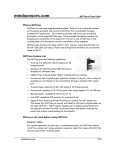Download MAXVME-6400TM User Manual
Transcript
VME64x IP carrier board Document N°: MANH402-51 TM MAXVME-6400 User Manual Version 1.2 MAXVME-6400 User Manual Rev 1.2 TM Copyright © 2007 MAX Technologies Inc. All rights reserved, including those to reproduce this publication or parts thereof in any form without prior written permission from MAX Technologies Inc. Printed in Canada. MAX Technologies, MAXVME-6400, and the MAX Technologies logo are all trademarks of MAX Technologies Inc. All other trademarks and registered trademarks are the property of their respective owners. Changes are periodically made to the information in this document. These changes will be incorporated into new editions of this document. MAX Technologies may make improvements and/or changes in the products and/or programs described in this document at any time. MAX Technologies Inc. makes no warranties as to the contents of this manual or the accompanying software. Although every effort has been made to ensure that the manual is accurate and that the software is reliable, MAX Technologies Inc. cannot be held responsible for any damages suffered from the use of this product. How to reach MAX Technologies for Product Support 7005 Taschereau Blvd., Suite 350 Brossard, Quebec Canada, J4Z 1A7 Tel.: (450) 443-3332 Fax: (450) 443-1618 Toll free: (800) 361-1629 www.maxt.com Page 2 MAX Technologies Rev 1.2 MAXVME-6400 User Manual MAXVME-6400 USER’S MANUAL HISTORY DOCUMENT REVISION Details Logic - Embedded Code PCB Revision 1.0 - First Release Rev 90001 Rev. 1.0 Revision 1.1 Rev 90002 - Added new LED functionality Rev. 1.0 Revision 1.2 Rev 90002 - Minor syntax corrections Rev. 1.0 MAX Technologies Page 3 MAXVME-6400 User Manual Rev 1.2 Table of Contents Table of Contents ............................................................................................................................................. 4 CHAPTER 1...................................................................................................................................................... 8 GENERAL INTRODUCTION ........................................................................................................................ 8 1.1 INTRODUCTION...................................................................................................................................... 8 CHAPTER 2.................................................................................................................................................... 10 ON-BOARD HARDWARE SPECIFICATION ............................................................................................ 10 2.1 Timer and Synchronization ...................................................................................................................... 10 2.1.1 System synchronization..................................................................................................................... 10 2.1.1.1 Slave card ................................................................................................................................... 10 2.1.1.2 Master with internal reference card ............................................................................................ 10 2.1.1.3 Master with external reference card ........................................................................................... 10 2.1.1.4 Master with VME_SYSCLK reference card .............................................................................. 11 2.1.1.5 Optional IRIG-B synchronization .............................................................................................. 12 2.1.1.6 Timer synchronization................................................................................................................ 12 2.2 Interrupt Time Tag Fifo............................................................................................................................ 13 2.3 Optional +/-15V DCDC ........................................................................................................................... 13 2.4 Temperature Sensor.................................................................................................................................. 13 CHAPTER 3.................................................................................................................................................... 14 PHYSICAL CONFIGURATION & INSTALLATION ................................................................................ 14 3.1 INTRODUCTION.................................................................................................................................... 14 3.2 Connector, switch and jumper.................................................................................................................. 15 3.2.1 IP position ......................................................................................................................................... 15 3.2.2 VME connector IO assignment ......................................................................................................... 15 3.2.3 J1 - J2 - +/-15V select........................................................................................................................ 16 3.2.4 JP1 ..................................................................................................................................................... 16 3.2.5 JP2 ..................................................................................................................................................... 16 3.2.6 JP3 ..................................................................................................................................................... 16 3.2.7 JP4 ..................................................................................................................................................... 16 3.2.8 Switch S2 – A24-CR/CSR and A16 Address range .......................................................................... 17 3.2.9 SW1-SW7 - Multi-board synchronization port connectors............................................................... 18 3.2.10 Status LED ...................................................................................................................................... 19 CHAPTER 4.................................................................................................................................................... 20 MEMORY & IO MAP ................................................................................................................................... 20 4.1 VME-6400 MEMORY MAP ................................................................................................................... 20 4.1.1 VME6400 IPack & Control register Memory Map........................................................................... 20 4.1.2 VME6400 IPack Memory Access ..................................................................................................... 21 4.1.3 VME6400 Geographical Addressing A16 and CR/CSR A24 memory access.................................. 21 4.2 CONTROL REGISTERS DEFINITION ................................................................................................. 25 4.2.1 Register Summary ............................................................................................................................. 25 4.2.1.1 Interrupt mask register (0x0000) ................................................................................................ 26 4.2.1.2 Interrupt flag register (0x0004) .................................................................................................. 26 4.2.1.3 IP configuration register (0x0008) ............................................................................................. 27 4.2.1.4 General control Register (0x000C) ............................................................................................ 28 4.2.1.5 64-bit timer register (0x0010 and 0x0014)................................................................................. 28 4.2.1.6 64-bit counter value at last IP interrupt (0x0018 and 0x001C) .................................................. 29 4.2.1.7 VME control (0x0020) ............................................................................................................... 30 4.2.1.8 A32_A24_IPMEMCONTROL control register (0x0024) ......................................................... 30 4.2.1.9 Temperature sensor data (0x0028 – 0x002C) ............................................................................ 31 Page 4 MAX Technologies Rev 1.2 MAXVME-6400 User Manual 4.2.1.10 IRIG-B correlation timer (0x0030-0x0034) .............................................................................31 4.2.1.11 IRIG-B data (0x0038)...............................................................................................................31 4.2.1.12 Model and Revision register (0x003C).....................................................................................32 4.2.1.13 User defined register (0x0070-0x7C) .......................................................................................32 4.2.1.14 User RAM (128 bytes) (0x0080-0x00FC)................................................................................32 CHAPTER 5 ....................................................................................................................................................33 INTERRUPTS................................................................................................................................................33 5.1 VME INTERRUPTS ................................................................................................................................33 CHAPTER 6 ....................................................................................................................................................34 SPECIFICATION...........................................................................................................................................34 6.1 ELECTRICAL..........................................................................................................................................34 6.2 MECHANICAL .......................................................................................................................................34 6.3 ENVIRONEMENTAL .............................................................................................................................34 MAX Technologies Page 5 MAXVME-6400 User Manual Rev 1.2 List of Figures Figure 1-1: MAXVME-6400 Block diagram .........................................................................................................9 Figure 3-1: IP and Switch position.......................................................................................................................14 Figure 3-2: GA base address circuit .....................................................................................................................17 Figure 3-3: SW1 to SW7 circuit...........................................................................................................................18 Page 6 MAX Technologies Rev 1.2 MAXVME-6400 User Manual List of Tables Table 2-1: MAXVME-6400 Synchronization configuration and states...............................................................11 Table 3-1: VME-64x back plane IO (P2) .............................................................................................................15 Table 3-2: VME-64x back plane IO (P0) .............................................................................................................16 Table 3-3: local base address settings...................................................................................................................17 Table 3-4: SW1 to SW7 description.....................................................................................................................18 Table 3-5: LED Definitions..................................................................................................................................19 Table 4-1: VME6400 IPack & Control register Memory Map ............................................................................20 Table 4-2: VME6400 IPack memory, A32 Memory Map....................................................................................21 Table 4-3: VME6400 IPack memory, A24 Memory Map....................................................................................21 Table 4-4a: VME6400, CR...................................................................................................................................22 Table 4-4b: VME6400, CR ..................................................................................................................................23 Table 4-5: VME6400, CSR ..................................................................................................................................24 Table 5-1: Interrupts routing to the VME bus interrupt system. ..........................................................................33 Table 6-1: VME6400 power requirement ............................................................................................................34 Table 6-2: MAXVME-6400 Environmental Specifications.................................................................................34 MAX Technologies Page 7 MAXVME-6400 User Manual Rev 1.2 CHAPTER 1 GENERAL INTRODUCTION 1.1 INTRODUCTION The MAXVME-6400 is an Industry Pack (IP) carrier board designed to be compliant with the VME64x, and supports the A32/A24/A16/D32/D16/D08, single and block access. It supports up to four single-width IP modules, or 2 double-width IP modules, where every IP bus has its independent 8MHz or 32 MHz clock. Features • 4 single (8 or 16 bit) or 2 double (32 bit) IP sites. • Per IP selectable operating frequency (8 or 32Mhz) and width (16 or 32 bit), no hold cycle. • 64-bit timer that can be frequency and phase synchronized between multiple VME-64 carriers and others MAX Technologies carrier boards. • Temperature sensor • IRIG-B circuitry • Optional +/-15V instead of regular +/-12V on IP modules • Four status LEDs. Page 8 MAX Technologies Rev 1.2 MAXVME-6400 User Manual The following figure presents the block diagram of the MAXVME-6400 board: VME64 IP0 VME P2 IP1 VME Back Plane Rear I/O IP2 VME P0 IP3 VME bus P1/P2 Transceiver & Quick Switch FPGA IRIG Circuit (optionnal) IRIG Signal Sync In/Out FLASH/ SDRAM (optionnal) DCDC +/-15V (optionnal) VCXO Figure 1-1: MAXVME-6400 Block diagram MAX Technologies Page 9 MAXVME-6400 User Manual Rev 1.2 CHAPTER 2 ON-BOARD HARDWARE SPECIFICATION 2.1 Timer and Synchronization The MAXVME-6400 has a 1 us resolution, 64-bit free running counter as main timer. This freerunning counter is accessible via the 64BIT_COUNTER registers. 2.1.1 System synchronization Many or a single MAXVME-6400 and the IPs on them can have their timer synchronized in phase and frequency with or without an external reference. To do so, the MAXVME-6400 cards must be daisychained using their input and output synchronization ports (SYNC_IN, SYNC_OUT). The resulting daisy-chained scheme is used to propagate the reference and synchronization symbols from the first card of the chain to the last one. This important feature gives the opportunity to have the same timebase over a complete system with a simple coax or twisted pair wire from a MAXVME-6400 to another. 2.1.1.1 Slave card The slave state is reached when the card detects reference symbols from a master card on its SYNC_IN port. The selected reference source must be the SYNC_IN port. The reference source is selected with REF_SRC bit of the GENERAL_CTRL register (see section 4.2.1.4). In this state INT_REF of the GENERAL_CTRL register is set to ‘0’ because the clock reference is external. 2.1.1.2 Master with internal reference card This master state is reached when the card does not detect an external reference or reference symbols and when the selected reference source is the SYNC_IN port. Then, the card uses its own VCXO for reference symbol generation on its SYNC_OUT port. Consequently the slave card attached to the master SYNC_OUT port locks its VCXO to the master VCXO. In this state INT_REF of the GENERAL_CTRL register is set to ‘1’ because the clock reference is internal. The VCXO of the master card can be calibrated for a specific operating temperature. Note that the MAXVME-6400 VCXO has a temperature stability of +/- 25 PPM over all the specified operating temperature range. The VCXO has a pulling range of +/- 100 PPM. The XO_CAL 8-bit value of the GENERAL_CTRL register (section 4.4.8) is used to calibrate the VCXO frequency. Writing a value to those bits will pull the VCXO to a corresponding frequency, 0x00 is pulling the VCXO down to the slowest frequency and 0xFF is pulling the VCXO up to the highest frequency. 2.1.1.3 Master with external reference card This master state is reached when the card detects an external 1Mhz clock on its SYNC_IN port but no reference symbols. The reference source is selected with the REF_SRC bit of the GENERAL_CTRL register (see section 4.4.8). When a master card detects this reference it automatically locks its onboard VCXO to this external reference. Then the card generates reference symbols on its SYNC_OUT port. Consequently the slave card attached to the master card SYNC_OUT port locks its VCXO to the reference too. An external reference connected to the SYNC_IN port of the master card must meet the following: 1- 1 MHz square wave +/- 100 PPM. 2- TTL level compatible. 3- 40-60% duty cycle. The difference between reference symbols and an external clock reference is the clock duty cycle. Page 10 MAX Technologies Rev 1.2 MAXVME-6400 User Manual 2.1.1.4 Master with VME_SYSCLK reference card This master state is reached when the external reference source is the VME_SYSCLK. The reference source is selected with the REF_SRC bit of the GENERAL_CTRL register (see section 4.4.8). The card locks its on-board VCXO to this external reference. Then the card generates reference symbols on its SYNC_OUT port. Consequently the slave card attached to the master card SYNC_OUT port locks its VCXO to that VME_SYSCLK too. In this state, INT_REF of the GENERAL_CTRL register is set to ‘0’ because the clock reference is external. When used, the VME system clock must meet the following: 1- 16 Mhz +/- 100 PPM accuracy IMPORTANT : Slave state is not possible when the VME system clock is selected as the external reference, because the card will never detect reference symbols generated by a master card. Only a desired master card should have the VME system clock as its external reference source. SYNCHRONIZATION STATUS Slave 0 : SYNC_IN port Master with internal reference 0 : SYNC_IN port Master with external reference Master with VME_SYSCLK reference 0 : SYNC_IN port 1 : VME_SYSCLK (1) (2) (3) REF_SRC bit (1) SYNC_IN port INT_REF bit (2) SYNC_OUT port of 0 : External Reference another MAXT card No external 1 : VCXO with XO_CAL reference detected External Reference 0 : External Reference Do not care 0 : External Reference MSTR_SLA bit (3) 0 : SLAVE 1 : MASTER 1 : MASTER 1 : MASTER See section 4.2.1.4 GENERAL_CTRL Register, bit 29. See section 4.2.1.4 GENERAL_CTRL Register, bit 24. See section 4.2.1.4 GENERAL_CTRL Register, bit 31. Table 2-1: MAXVME-6400 Synchronization configuration and states MAX Technologies Page 11 MAXVME-6400 User Manual Rev 1.2 2.1.1.5 Optional IRIG-B synchronization The MAXVME-6400 can also optionally be synchronized on an external IRIG-B signal if your carrier comes with the IRIG-B decoder circuitry. If so, when the IRIGB_ENABLE bit is activated and the IRIG-B signal is connected to IRIG-B_IN, the MAXVME-6400 will synchronies its internal clock and timer on the incoming signal by automatically adjusting the VCXO. The decoder logic accepts both TTL and standard amplitude-modulated (AM) IRIG-B signal. When using the TTL input, the 1us synchronicity is exact since the rising edge of the TTL output corresponds exactly to the Pr point. When using an AM IRIG-B signal, the decoder circuitry and logic will synchronize on the zero crossing of the beginning of the Pr point of the AM modulated signal. This zero crossing of the low frequency AM modulated signal is not as accurate as the TTL or 1PPS signal. So, the user may use a 1PPS signal on the TTL input to improve synchronicity when using the IRIG-B AM signal or compensate. Note that when the card is in the SLAVE state, the IRIGB_ENABLE is ignored, and the card is synchronized with the MASTER card. Note that the IRIG-B signal should be standard amplitude modulated IRIG-B signals in the range of 0.1 to 10 Vpp. Both, signal and ground, IRIG-B pins must be connected for correct decoding. The decoded IRIG-B data and the registered value of the 64-bit timer are available for correlation between the two timing methods. See register section for detail. 2.1.1.6 Timer synchronization The timer present on some IP modules as well as the 64-bit free running counter of the MAXVME6400 can all be synchronized in phase. The RST_CNT bit of the INTERRUPT_MASKS register (section 4.2.1.1) resets the free running counter and also sends a 0.125 us low pulse on the IP STROBE lines that may be used to reset IP modules timers1. When writing 1 to the RST_CNT bit of the master card, a reset symbol is generated to the SYNC_OUT port and consequently all over the cards chain. The detection of this reset symbol by the slave cards resets their free running counter and also sends a 0.125 us low pulse on their IP STROBE signal. On a master or a slave card, the SYNC_DONE bit of the GENERAL_CTRL register indicates when such a timer/counter reset occurred (see section 4.2.1.4). IMPORTANT: When writing a 1 to the RST_CNT bit of the INTERRUPT_MASKS of a slave card, no synchronization symbol is generated to the SYNC_OUT port of this card, but it resets the counters of this card only. 1 All MAX Technologies IP modules support this feature, however it is not specified in the IP specification. Other manufacturers may not support this feature. Page 12 MAX Technologies Rev 1.2 MAXVME-6400 User Manual 2.2 Interrupt Time Tag Fifo It is possible for the user to obtain the value of the 64BIT_COUNTER register at the time of all the incoming IP interrupt sources. Activating the INTCNT_enable bit in IP_Configuration register enables this feature. By doing so, the IP interrupts will only be presented one at a time. The associated countertimer value is available in the INT_COUNT register. If more then one interrupt is received from the IP modules, the associated counter values are memorized and will be presented once the first interrupt is cleared. There is no obligation to read the INT_COUNT even if the option is enabled. 2.3 Optional +/-15V DCDC The MAXVME-6400 is optionally equipped with two DCDC converters, which can provide +/-15V instead of +/-12V to the IP modules. Those DCDC can provide up to 260mA per output and are powered by the VME bus 5V. The user can choose +/-15V by setting the J1 and J2 jumpers. 2.4 Temperature Sensor The MAXVME-6400 is equipped with 4 temperatures sensor, which are place near each IP module sites, and give the possibility to monitor the temperature of the board during operation. The temperature is available with a 0.5°C precision. See register section for detail. MAX Technologies Page 13 MAXVME-6400 User Manual Rev 1.2 CHAPTER 3 PHYSICAL CONFIGURATION & INSTALLATION 3.1 INTRODUCTION This section covers the physical configuration of the MAXVME-6400 board: • • • • • IP position and IO connectors pin-out Serial port pin-out VME address range setting dipswitches Board to board synchronization port connector Reset button and status LEDs Figure 3-1: IP and Switch position Page 14 MAX Technologies Rev 1.2 MAXVME-6400 User Manual 3.2 Connector, switch and jumper 3.2.1 IP position Figure 3.1 above shows the position of the 4 IP modules that can support a MAXVME-6400 board. Single size IPs may use any of the four slots shown. Double size IPs may use slot A&B or C&D. 3.2.2 VME connector IO assignment The two following table present the IP modules IO connection to the VME connector P0 and P2. Note that the IOs are connected as indicated in specification “VITA 4.1-1996 ; IP I/O Mapping to VME64x”. Row VME Connector Position d c a z P2 P2 P2 P2 P2 P2 P2 P2 P2 P2 P2 P2 P2 P2 P2 P2 P2 P2 P2 P2 P2 P2 P2 P2 P2 P2 P2 P2 P2 P2 P2 P2 1 2 3 4 5 6 7 8 9 10 11 12 13 14 15 16 17 18 19 20 21 22 23 24 25 26 27 28 29 30 31 32 IPC-IO47 IPC-IO48 IPC-IO50 IPB-IO1 IPB-IO3 IPB-IO4 IPB-IO6 IPB-IO7 IPB-IO9 IPB-IO10 IPB-IO12 IPB-IO13 IPB-IO15 IPB-IO16 IPB-IO18 IPB-IO19 IPB-IO21 IPB-IO22 IPB-IO24 IPB-IO25 IPB-IO27 IPB-IO28 IPB-IO30 IPB-IO31 IPB-IO33 IPB-IO34 IPB-IO36 IPB-IO37 IPB-IO39 IPB-IO40 GND VPC IPB-IO42 IPB-IO44 IPB-IO46 IPB-IO48 IPB-IO50 IPA-IO2 IPA-IO4 IPA-IO6 IPA-IO8 IPA-IO10 IPA-IO12 IPA-IO14 IPA-IO16 IPA-IO18 IPA-IO20 IPA-IO22 IPA-IO24 IPA-IO26 IPA-IO28 IPA-IO30 IPA-IO32 IPA-IO34 IPA-IO36 IPA-IO38 IPA-IO40 IPA-IO42 IPA-IO44 IPA-IO46 IPA-IO48 IPA-IO50 3.3V 5V IPB-IO41 IPB-IO43 IPB-IO45 IPB-IO47 IPB-IO49 IPA-IO1 IPA-IO3 IPA-IO5 IPA-IO7 IPA-IO9 IPA-IO11 IPA-IO13 IPA-IO15 IPA-IO17 IPA-IO19 IPA-IO21 IPA-IO23 IPA-IO25 IPA-IO27 IPA-IO29 IPA-IO31 IPA-IO33 IPA-IO35 IPA-IO37 IPA-IO39 IPA-IO41 IPA-IO43 IPA-IO45 IPA-IO47 IPA-IO49 3.3V 5V IPC-IO46 GND IPC-IO49 GND IPB-IO2 GND IPB-IO5 GND IPB-IO8 GND IPB-IO11 GND IPB-IO14 GND IPB-IO17 GND IPB-IO20 GND IPB-IO23 GND IPB-IO26 GND IPB-IO29 GND IPB-IO32 GND IPB-IO35 GND IPB-IO38 GND 3.3V GND Table 3-1: VME-64x back plane IO (P2) MAX Technologies Page 15 MAXVME-6400 User Manual Rev 1.2 Row VME Connector P0 P0 P0 P0 P0 P0 P0 P0 P0 P0 P0 P0 P0 P0 P0 P0 P0 P0 P0 Position 1 2 3 4 5 6 7 8 9 10 11 12 13 14 15 16 17 18 19 f GND GND GND GND GND GND GND GND GND GND GND GND GND GND GND GND GND GND GND e IPD-IO5 IPD-IO10 IPD-IO15 IPD-IO20 IPD-IO25 IPD-IO30 IPD-IO35 IPD-IO40 IPD-IO45 IPD-IO50 IPC-IO5 IPC-IO10 IPC-IO15 IPC-IO20 IPC-IO25 IPC-IO30 IPC-IO35 IPC-IO40 IPC-IO45 d IPD-IO4 IPD-IO9 IPD-IO14 IPD-IO19 IPD-IO24 IPD-IO29 IPD-IO34 IPD-IO39 IPD-IO44 IPD-IO49 IPC-IO4 IPC-IO9 IPC-IO14 IPC-IO19 IPC-IO24 IPC-IO29 IPC-IO34 IPC-IO39 IPC-IO44 c IPD-IO3 IPD-IO8 IPD-IO13 IPD-IO18 IPD-IO23 IPD-IO28 IPD-IO33 IPD-IO38 IPD-IO43 IPD-IO48 IPC-IO3 IPC-IO8 IPC-IO13 IPC-IO18 IPC-IO23 IPC-IO28 IPC-IO33 IPC-IO38 IPC-IO43 b IPD-IO2 IPD-IO7 IPD-IO12 IPD-IO17 IPD-IO22 IPD-IO27 IPD-IO32 IPD-IO37 IPD-IO42 IPD-IO47 IPC-IO2 IPC-IO7 IPC-IO12 IPC-IO17 IPC-IO22 IPC-IO27 IPC-IO32 IPC-IO37 IPC-IO42 a IPD-IO1 IPD-IO6 IPD-IO11 IPD-IO16 IPD-IO21 IPD-IO26 IPD-IO31 IPD-IO36 IPD-IO41 IPD-IO46 IPC-IO1 IPC-IO6 IPC-IO11 IPC-IO16 IPC-IO21 IPC-IO26 IPC-IO31 IPC-IO36 IPC-IO41 Table 3-2: VME-64x back plane IO (P0) 3.2.3 J1 - J2 - +/-15V select The MAXVME-6400 offers the possibility to change the regular +/-12V supplied by the VME chassis to the IP modules, by an optional +/-15V from DC-DC converters. The jumper J1 and J2 are used to select between the two values. The default configuration is that the board comes without the DC-DC converter and jumper are replaced by a shut wire on the +/-12V side. If the DC-DC are in place, the jumper are set on position +/-12V by default. Note that every IP modules are linked to the same power source, therefore the user must be very careful when using +/-15V. 3.2.4 JP1 Reserved for internal use. 3.2.5 JP2 Used for backward compatibility with older MAXT Ipack carrier card synchronization. Connect pin 7 & 8 for referential SYNC_IN in correlation with SW4. The rest of JP2 is reserved for internal use. 3.2.6 JP3 Reserved for internal/future use. 3.2.7 JP4 This jumper is used to supply the 3.3V from the 5V power source when using the MAXVME-6400 in a legacy standard VME card cage. This jumper should not be placed when used on a standard VME64 card cage ( default ). Page 16 MAX Technologies Rev 1.2 MAXVME-6400 User Manual 3.2.8 Switch S2 – A24-CR/CSR and A16 Address range The MAXVME-6400 support multiple addressing access, A16, A24 or A32. On power up, the board is accessible through A16 or A24 CR/CSR mode. On a standard VME64 frame system, the A16 and CR/CSR A24 base address will be defined by the Geographical Address. But it is possible to disable the Geographical Address and use a local base address configured by dipswitch. The following figure represents the schematics related to the dipswitch bypass and GA settings. EN Switch S2 Vcc 4 Vcc 3 Vcc 2 Vcc 1 Vcc 0 GA[4..0] Vcc Vcc NOTE: Each GA lines must be connected to a pull up. See VME64x specification Mux/Demux Bus Switch to FPGA Figure 3-2: GA base address circuit On power up, the FPGA will access the VME system Geographical Address (GA), compute the parity and compare the result with the GA Parity read on VME system. If valid, the VME GA will be kept as the A16 and CR/CSR A24 base address. If not, the local dipswitch settings will be taken, even if an invalid address is found (a valid GA must have a value between 1 and 21 inclusively). Note that it is possible to force the local A16 and CR/CSR A24 base address by switching the EN switch to “on”. The following table summarizes the definition of the different switches of S2. Switch Number 1-4 5-9 10 Definition Reserved/future use ( default = OFF ) Local base address selector Equivalent to the GA4 to GA0. Local base address Enable When set to “on”, it will force the base address to the local dipswitch setting. Table 3-3: local base address settings MAX Technologies Page 17 MAXVME-6400 User Manual Rev 1.2 3.2.9 SW1-SW7 - Multi-board synchronization port connectors As mentioned previously, the MAXVME-6400 has input/output synchronization ports identified as SYNC_IN and SYNC_OUT that are used to synchronize multiple boards together. The boards are also optionally equipped with an IRIG-B circuitry, which can be used to synchronize a master board to an IRIG-B signal. The MAXVME-6400 can use those synchronization devices through the back plane, bypassing parallel IP IO, or through the front BNC connector (only available on convection cooled board). Since back plane IO are already assigned to IP modules IO, using the back plane setting will imply disconnecting the corresponding IP IO. The selection is made with SW1 to SW7; the following figure represents the schematics of those switches. Switch POS0 Front Plate BNC Sync Signal VME Back Plane IPx IOx Switch POS1 No Connect Figure 3-3: SW1 to SW7 circuit Note that POS0 on the switches are represented by a DOT. This table gives the connection between the switches, synchronization signals, front plate connector, back plane connector and IP IO signals. Switch Number Synchronization Signal SW1 SW2 SW3 SW5 SW6 SW7 IRIGB IRIGB_DIGITAL SYNC_IN_L SYNC_IN SYNC_OUT_L SYNC_OUT Front Plate BNC Connector P1.1 P2.1 P3.2 P3.1 P4.2 P4.1 VME Back Plane Connector VME_P2.C5 VME_P2.C30 VME_P2.Z3 VME_P2.D3 VME_P0.D10 VME_P0.E10 Correspondin g IP IO IPB_IO50 IPA_IO50 IPC_IO49 IPC_IO50 IPD_IO49 IPD_IO50 Table 3-4: SW1 to SW7 description The remaining switch, SW4, is used to select between differential (POS0) or referential (POS1) SYNC_IN and SYNC_OUT signals. This is done so that the MAXVME-6400 card can be compatible with old MAX Technologies carrier boards, which were referential (see also JP2 pin 7&8). Note that when using only MAXVME-6400 cards, the users should select differential (POS0), because of the improved resistance to noise that it offers. Page 18 MAX Technologies Rev 1.2 MAXVME-6400 User Manual 3.2.10 Status LED When used in a conventional VME card cage, the MAXVME-6400 is equipped with four LEDs on the front plate which gives the user the status of the card. The following table presents the default signification of each LED. LED1 This LED is flashing when the card is on. LED2 This LED is on when an IP_ERROR_L is received from one of the 4 IP modules. LED3 This LED is flashing when the IP modules are accessed (READ). LED4 This LED is flashing when the IP modules are accessed (WRITE). Table 3-5: LED Definitions Note that it is possible to control the LED through the General Control Register (0x0C), by setting the bit REG_LED_EN to one. (See section 4.2.1.4) MAX Technologies Page 19 MAXVME-6400 User Manual Rev 1.2 CHAPTER 4 MEMORY & IO MAP 4.1 VME-6400 MEMORY MAP 4.1.1 VME6400 IPack & Control register Memory Map The VME6400 board uses 32-bit, 24-bit and 16-bit address range (A32/A24/A16), depending on the resource that is accessed. The A32 and A24 base address gives access to the same region, only the available range differs. The following table presents the different access with their corresponding base address. Address A16 Base + 0x0000 A16 Base + 0x007F A16 Base + 0x0080 A16 Base + 0x009F A16 Base + 0x0100 A16 Base + 0x017F A16 Base + 0x0180 A16 Base + 0x019F A16 Base + 0x0200 A16 Base + 0x027F A16 Base + 0x0280 A16 Base + 0x029F A16 Base + 0x0300 A16 Base + 0x037F A16 Base + 0x0380 A16 Base + 0x039F A16 Base + 0x0400 A16 Base + 0x07FF Access IPA I/O Space Range 128 bytes IPA ID Space 32 bytes Reserved IPB I/O Space 96 bytes 128 bytes IPB ID Space 32 bytes Reserved IPC I/O Space 96 bytes 128 bytes IPC ID Space 32 bytes Reserved IPD I/O Space 96 bytes 128 bytes IPD ID Space 32 bytes Reserved VME6400 Registers (and others) 96 bytes 1024 bytes Table 4-1: VME6400 IPack & Control register Memory Map Page 20 MAX Technologies Rev 1.2 MAXVME-6400 User Manual 4.1.2 VME6400 IPack Memory Access You may configure the VME-6400 to access the Ipack memory region in A24 or A32. Depending on your need it will give you the possibility to access the totality of the Ipack memory region or use less VME memory space. Address A32 Base + 0x01FFFFFF A32 Base + 0x01800000 A32 Base + 0x017FFFFF A32 Base + 0x01000000 A32 Base + 0x00FFFFFF A32 Base + 0x00800000 A32 Base + 0x007FFFFF A32 Base + 0x00000000 Access IP D Memory Space Range 8 Mbytes IP C Memory Space 8 Mbytes IP B Memory Space 8 Mbytes IP A Memory Space 8 Mbytes Table 4-2: VME6400 IPack memory, A32 Memory Map Address A24 Base + 0x07FFFF A24 Base + 0x060000 A24 Base + 0x05FFFF A24 Base + 0x040000 A24 Base + 0x03FFFF A24 Base + 0x020000 A24 Base + 0x01FFFF A24 Base + 0x000000 Access IP D Memory Space Range 128kbytes IP C Memory Space 128kbytes IP B Memory Space 128kbytes IP A Memory Space 128kbytes Table 4-3: VME6400 IPack memory, A24 Memory Map 4.1.3 VME6400 Geographical Addressing A16 and CR/CSR A24 memory access Through Geographical Addressing (GA) capability as stated in the VME64x specification, the VME6400 Ipack carrier give direct access to the CR/CSR A24 address space to inform the system of the card capacity and configuration. The CR/CSR Base Address and also the default A16 base address register value are derived from the geographical address upon system initialization. This will permit the system to automatically identify into which VME64x back plane slot the VME6400 is inserted. The geographical address pins are set by the system backplane with unique slot addresses and are routed via the P1 connector. If the VME6400 is to be utilized into a standard VME frame it is possible to bypass the VME64 back plane GA addressing ( See 3.7 switch S2 ). The CR/CSR base address will remain link to the GA setting while the A16 base address may be configured/change through the CSR function 0 ADER ( address decode compare register ). The Ipack memory space base address access may also be configured directly in the CSR ADER or through the A16 configuration register ( see A32_A24_IPMEMCONTROL ). The following tables are a brief description of the VME64x specification with values for the VME6400 Ipack carrier card. For more details consult the “vita-1-1994 VME64”, and “Vita-1.1-1997 VME64x” standard. Note that all unused or unimplemented locations in the defined CR and CSR area will be mark as “All 0x00”. MAX Technologies Page 21 MAXVME-6400 User Manual Rev 1.2 CR Address Content [MSB ............. LSB] 0x03 0x07, 0x0B, 0x0F 0x13 Size Checksum 1 byte Length of ROM 3 bytes Configuration ROM data access width (Accepts D32, D16 or D08(E0) cycles) 1 byte CSR Data access width (Accepts D32, D16 or D08(E0) cycles) 1 byte CR/CSR Space Specification ID 1 byte 0x43 (ASCII "C") 1 byte 0x52 (ASCII "R") 1 byte Manufacturer's ID (IEEE OUI) 3 bytes 0x17 0x1B 0x1F 0x23 0x27, 0x2B, 0x2F 0x33, 0x37, 0x3B, 0x3F Board ID supplied by manufacturer 0x43, 0x47, 0x4B, 0x4F Revision ID supplied by manufacturer 0x53, 0x57, 0x5B 0x5F to 0x7B 0x7F 0x83, 0x87, 0x8B 0x8F, 0x93, 0x97 0x9B, 0x9F, 0xA3 0xA7, 0xAB, 0xAF 0xB3, 0xB7, 0xBB 0xBF, 0xC3, 0xC7 0xCB, 0xCF, 0xD3 0xD7, 0xDB, 0xDF 0xE3 0xE7 0xEB 0xEF 0xF3 0xF7 0xFB 0xFF 0x103 0x107 0x10B Relevant VME6400 Standard VALUE VME64 VME64 0xCD 0xFF,0x0F,0x00 VME64 0x84 VME64 VME64 VME64 VME64 VME64 0x84 0x02 0x43 0x52 0x00,0x00,0x00 4 bytes VME64 0x09,0x00,0x00,0x00 4 bytes VME64 0x01,0x00,0x00,0x00 Pointer to a null terminated ASCII printable string or 0x000000 3 bytes RESERVED 8 bytes Program ID code 1 byte Offset to BEG_USER_CR 3 bytes Offset to END_ USER_CR 3 bytes Offset to BEG_CRAM 3 bytes Offset to END_CRAM 3 bytes Offset to BEG_USER_CSR 3 bytes Offset to END_ USER_CSR 3 bytes Offset to BEG_SN 3 bytes Offset to END_SN 3 bytes Slave Characteristics Parameter ( Slave implements P2 connector and uses ETL transceivers ) 1 byte User-defined Slave Characteristics 1 byte Master Characteristics Parameter 1 byte User-defined Master Characteristics 1 byte Interrupt Handler Capabilities 1 byte Interrupter Capabilities ( 1 byte Reserved, Read as zero 1 byte CRAM_ACCESS_WIDTH, 1 byte Function 0 Data Access Width DAWPR (Accepts D32, D16 or D08(E0) cycles) 1 byte Function 1 Data Access Width (Accepts D32, D16 or D08(E0) cycles) 1 byte Function 2 Data Access Width (Accepts D32, D16 or D08(E0) cycles) 1 byte VME64 VME64 VME64 VME64x VME64x VME64x VME64x VME64x VME64x VME64x VME64x 0x00,0x00,0x00 All 0x00 All 0x00 All 0x00 All 0x00 All 0x00 All 0x00 All 0x00 All 0x00 All 0x00 All 0x00 VME64x VME64x VME64x VME64x VME64x VME64x VME64x VME64x 0x06 All 0x00 All 0x00 All 0x00 All 0x00 0xFE All 0x00 All 0x00 VME64x 0x84 VME64x 0x84 VME64x 0x84 Table 4-4a: VME6400, CR Page 22 MAX Technologies Rev 1.2 CR Address [MSB ....... LSB] 0x10F 0x113 0x117 0x11B 0x11F 0x123 ... 0x13F 0x143 ... 0x15F 0x163 ... 0x17F 0x183 ... 0x19F 0x1A3 ... 0x1BF 0x1C3... 0x1DF 0x1E3 ... 0x1FF 0x203 ... 0x21F 0x223 ... 0x61F 0x623 ... 0x62F 0x633 ... 0x63F 0x643 ... 0x64F 0x653 ... 0x65F 0x663 ... 0x66F 0x673 ... 0x67F 0x683 ... 0x68F 0x693 ... 0x69F 0x6A3… 0x6AB 0x6AF 0x6B3... 0x6CF 0x6D3 ... 0x74F 0x753 ... 0xFFF MAXVME-6400 User Manual Content Size Function 3 Data Access Width 1 byte Function 4 Data Access Width 1 byte Function 5 Data Access Width 1 byte Function 6 Data Access Width 1 byte Function 7 Data Access Width 1 byte Function 0 AM Code Mask AMCAP ( A16 supervisory and non-privileged access supported ) 8 bytes Function 1 AM Code Mask (all access type supported in A24 except 64-bit MBLT mode ) 8 bytes Function 2 AM Code Mask (all access type supported in A32 except 64-bit MBLT mode ) 8 bytes Function 3 AM Code Mask 8 bytes Function 4 AM Code Mask 8 bytes Function 5 AM Code Mask 8 bytes Function 6 AM Code Mask 8 bytes Function 7 AM Code Mask 8 bytes Function 0 to 7 XAM Code Mask XAMCAP 256 bytes Function 0 Address Decoder Mask ADEM (A16 memory access use address bit A15 to A11, 2KB boundary ) 4 bytes Function 1 ADEM (A24 memory access use address bit A23 to A19, 512KB boundary ) 4 bytes Function 2 ADEM (A32 memory access use address bit A31 to A25, 32MB boundary ) 4 bytes Function 3 ADEM 4 bytes Function 4 ADEM 4 bytes Function 5 ADEM 4 bytes Function 6 ADEM 4 bytes Function 7 ADEM 4 bytes Reserved, read as zero 3 byte Master Data Access Width DAWPR 1 byte Master AM Capability AMCAP 8 bytes Master XAM Capability XAMCAP 32 bytes RESERVED 555 bytes Relevant Standard VME64x VME64x VME64x VME64x VME64x VME6400 VALUE All 0x00 All 0x00 All 0x00 All 0x00 All 0x00 0x00,0x00,0x22,0x00 VME64x 0x00,0x00,0x00,0x00 0XEE,0x00,0x00,0x00 VME64x 0x00,0x00,0x00,0x00 VME64x VME64x VME64x VME64x VME64x VME64x 0x00,0x00,0x00,0x00 0x00,0x00,0xEE,0x00 All 0x00 All 0x00 All 0x00 All 0x00 All 0x00 VME64x All 0x00 VME64x 0x00,0x00,0xF8,0x00 VME64x 0x00,0xF8,0x00,0x00 VME64x VME64x VME64x VME64x VME64x VME64x VME64x VME64x VME64x VME64x VME64x 0xFE,0x00,0x00,0x00 All 0x00 All 0x00 All 0x00 All 0x00 All 0x00 All 0x00 All 0x00 All 0x00 All 0x00 All 0x00 Table 4-4b: VME6400, CR MAX Technologies Page 23 MAXVME-6400 User Manual Rev 1.2 The Configuration status register (CSR) will be use in order to provide Address Space Relocation. Note that A24 and A32 base address definition may also be configured through the A32_A24_IPMEMCONTROL register while A16 base address definition may only be changed through the CSR. Note also that if you can modify the A32 and A24 base address access by the CSR, the system most still enable it in the A32_A24_IPMEMCONTROL. CSR Address [MSB ............. LSB] Content Size Relevant VME6400 Standard Value 0x7FFFF 0x7FFFB 0x7FFF7 0x7FFF3 CR/CSR (BAR) Base Address Register ( set by GA ) 1 byte Bit Set Register 1 byte Bit Clear Register 1 byte CRAM_OWNER Register 1 byte VME64 VME64 VME64 VME64x 0x7FFEF User-Defined Bit Set Register 1 byte VME64x All 0x00 0x7FFEB 0x7FFE3 ... 0x7FFE7 0x7FFD3 ... 0x7FFDF 0x7FFC3 ... 0x7FFCF 0x7FFB3 ... 0x7FFBF 0x7FFA3 ... 0x7FFAF User-Defined Bit Clear Register RESERVED Function 7 ADER Function 6 ADER Function 5 ADER Function 4 ADER 1 byte 2 bytes 4 bytes 4 bytes 4 bytes 4 bytes VME64x VME64x VME64x VME64x VME64x VME64x 0x7FF93 ... 0x7FF9F Function 3 ADER 4 bytes Function 2 ADER2 ( A32 base 0x7FF83 ... 0x7FF8F address ) 4 bytes Function 1 ADER2 ( A24 base 0x7FF73 ... 0x7FF7F address ) 4 bytes Function 0 ADER2 ( A16 base 0x7FF63 ... 0x7FF6F address ) 4 bytes 0x7FC00 ... 0x7FF5F RESERVED 216 bytes 0xGA1 All 0x00 All 0x00 All 0x00 All 0x00 All 0x00 All 0x00 All 0x00 All 0x00 All 0x00 All 0x00 VME64x VME64x 0x00*,0x00,0x00,0x00** VME64x 0x00,0x00*,0x00,0x00** VME64x 0x00,0x00,0xGA3*,0x00** VME64x 1 : 0xGA ; Geographical address reed : ADER ; Address Decoder compare register 3 : The default is that the A16 ADER will be set by the GA, but it may be modified by the user. * : Only the byte marked with an asterisk are relevant and can be modified. See also ADEM in CR. ** : AM mask is not supported yet, all access mode type are supported by default. 2 Table 4-5: VME6400, CSR Page 24 MAX Technologies Rev 1.2 MAXVME-6400 User Manual 4.2 CONTROL REGISTERS DEFINITION 4.2.1 Register Summary Address Offset 0x0000 0x0004 0x0008 0x000C 0x0010 0x0014 0x0018 0x001C 0x0020 0x0024 0x0028 0x002C 0x0030 0x0034 0x0038 0x003C 0x0040 – 0x068 0x006C 0x0070-0x007C 0x0080-0x00FC MAX Technologies Register name INTERRUPT_MASKS INTERRUPT_FLAGS IP_CONFIGURATION GENERAL_CTRL 64BIT_COUNTER (HIGH) 64BIT_COUNTER (LOW) INT_FIFO (HIGH) INT_FIFO (LOW) VME_CTRL A32_A24_IPMEMCONTROL TEMP_SENSOR_DATA (IP #1 and IP #0) TEMP_SENSOR_DATA (IP #3 and IP #2) IRIGB_TIMER (HIGH) IRIGB_TIMER (LOW) IRIGB_DATA MODEL AND REVISION NUMBER Reserved for future use. EPCS ACCESS User Defined (Set to 0 on system reset) 128 bytes RAM Block Page 25 MAXVME-6400 User Manual Rev 1.2 4.2.1.1 Interrupt mask register (0x0000) Bit # 0 1 2 3 4 5 6 7 8-15 16-23 24 25 26 27 28-30 31 Access R/W R/W R/W R/W R/W R/W R/W R/W R R R/W R/W R/W R/W R W Name IPVMEM0 IPVMEM1 IPVMEM2 IPVMEM3 IPVMEM4 IPVMEM5 IPVMEM6 IPVMEM7 N.U. N.U. IPEM0 IPEM1 IPEM2 IPEM3 N.U. RST_CNT Function IPA INTREQ0 to VME interrupt enable IPA INTREQ1 to VME interrupt enable IPB INTREQ0 to VME interrupt enable IPB INTREQ1 to VME interrupt enable IPC INTREQ0 to VME interrupt enable IPC INTREQ1 to VME interrupt enable IPD INTREQ0 to VME interrupt enable IPD INTREQ1 to VME interrupt enable Not used Not used IPA ERROR interrupt enable IPB ERROR interrupt enable IPC ERROR interrupt enable IPD ERROR interrupt enable Not used Writing a one to this bit resets the main timer and the timer of all the IP modules as well as the timer present on other slave carriers. (Used by the master carrier only) See SYNC_DONE bit of the GENERAL_CTRL register. Reset Value 0 : Disabled 0 : Disabled 0 : Disabled 0 : Disabled 0 : Disabled 0 : Disabled 0 : Disabled 0 : Disabled 0 0 0 : Disabled 0 : Disabled 0 : Disabled 0 : Disabled 0 0 : Disabled 4.2.1.2 Interrupt flag register (0x0004) Bit # 0-7 8 9 10 11 12 13 14 15 16-23 24 25 26 27 28 Access R R R R R R R R R R R R R R R/W Name Reserved IPF0 IPF1 IPF2 IPF3 IPF4 IPF5 IPF6 IPF7 Reserved IPEF0 IPEF1 IPEF2 IPEF3 IPXF0 29 R/W IPXF1 30 R/W IPXF2 31 R/W IPXF3 Page 26 Function Future use IPA INTREQ0 interrupt flag IPA INTREQ1 interrupt flag IPB INTREQ0 interrupt flag IPB INTREQ1 interrupt flag IPC INTREQ0 interrupt flag IPC INTREQ1 interrupt flag IPD INTREQ0 interrupt flag IPD INTREQ1 interrupt flag Future use IPA ERROR flag IPB ERROR flag IPC ERROR flag IPD ERROR flag IPA exception flag (“sticky bit”, cleared when written with a “1”) IPB exception flag (“sticky bit”, cleared when written with a “1”) IPC exception flag (“sticky bit”, cleared when written with a “1”) IPD exception flag (“sticky bit”, cleared when written with a “1”) Reset Value 0: Disabled 0:Disabled 0:Disabled 0:Disabled 0:Disabled 0:Disabled 0:Disabled 0:Disabled 0:Disabled 0: Disabled 0:Disabled 0:Disabled 0:Disabled 0:Disabled 0:Disabled 0:Disabled 0:Disabled 0:Disabled MAX Technologies Rev 1.2 MAXVME-6400 User Manual 4.2.1.3 IP configuration register (0x0008) Bit # 0-15 16 17 Access R/W R/W R/W Name Reserved IPAWIDTH0 IPAWIDTH1 Function Future use IPA bus width bit 0 IPA bus width bit 1 Reset Value 0 : Disabled 0 0 Bits effect 00 ! 8 bit 01 ! 16 bit 1X ! 32 bit 18 19 20 21 22 23 24 R/W R/W R/W R/W R/W R/W R/W IPBWIDTH0 IPBWIDTH1 IPCWIDTH0 IPCWIDTH1 IPDWIDTH0 IPDWIDTH1 IPSPEED0 25 26 27 28-30 31 R/W R/W R/W R R IPSPEED1 IPSPEED2 IPSPEED3 N.U. INTCNT_enable MAX Technologies IPB bus width bit 0 IPB bus width bit 1 IPC bus width bit 0 IPC bus width bit 1 IPD bus width bit 0 IPD bus width bit 1 IPA clock set 0: 8 MHz 1: 32 MHz IPB clock set IPC clock set IPD clock set Not used Counter value at interrupt enable. 0 0 0 0 0 0 0 0 0 0 0 0 Page 27 MAXVME-6400 User Manual Rev 1.2 4.2.1.4 General control Register (0x000C) Bit # 0 Access Name RW IPRESET0 1 RW IPRESET1 2 RW IPRESET2 3 RW IPRESET3 4 5 6 7 8 R/W R/W R/W R/W R/W LED0 LED1 LED2 LED3 REG_LED_EN 13-9 14 15 R R/W R/W N.U. IRIG_TTL_EN IRIG_TTL_1PPS 23-16 R/W XO_CAL 24 R INT_REF 25 28-26 29 R/W R/W R/W IRIGB_ENABLE N.U. REF_SRC 30 R/W SYNC_DONE 31 R MSTR_SLA Function Writing a 1 to this bit deactivates the RESET# pin of the IPA. Writing a 1 to this bit deactivates the RESET# pin of the IPB. Writing a 1 to this bit deactivates the RESET# pin of the IPC. Writing a 1 to this bit deactivates the RESET# pin of the IPD. Writing a 1 to this bit deactivates led 0 Writing a 1 to this bit deactivates led 1 Writing a 1 to this bit deactivates led 2 Writing a 1 to this bit deactivates led 3 Enables the LED control with the register (bit 4 to 7). The default led signification is explained in section 3.2.10. Not Used IRIG-B TTL input enable IRIG-B TTL configuration. When set to 0, the IRIG-B source is the TTL input, when set to 1, the TTL input is a 1PPS signal used in conjunction with the IRIG-B AM input. Calibration value for the VCXO. Reset value is in the middle of the frequency range. When the card PLL is not referenced to any source, so that it is in the master mode. When 1 : Internal reference with XO_CAL When 0 : External reference or VME_SYSCLK IRIG-B synchronization enable Not Used When 0 : SYNC_IN port is selected When 1 : VME_SYSCLK is selected Card synchronization done status (“sticky bit”, cleared when written with a “1”) When 1, card is master When 0, card is slave Master means that the board generates clock and reset for other boards. Reset Value 0 : Activated 0 : Activated 0 : Activated 0 : Activated 0 0 0 0 0 0 0 0 0x7F X 0 0 0 0:Disabled X 4.2.1.5 64-bit timer register (0x0010 and 0x0014) Bit # 63-32 Access R Name COUNT 31-0 R COUNT Page 28 Function High 32 bits of the 64BIT_COUNTER at 1 MHz. This is the main timer of the carrier board Low 32 bits of the 64BIT_COUNTER at 1 MHz. This is the main timer of the carrier board Reset Value 0x00000000 0x00000000 MAX Technologies Rev 1.2 MAXVME-6400 User Manual 4.2.1.6 64-bit counter value at last IP interrupt (0x0018 and 0x001C) Bit # 63-32 Access R Name INT_COUNT 31-0 R INT_COUNT MAX Technologies Function This register gives the High value of 64BIT_COUNTER stored in the FIFO at last interrupt edge. This register gives the Low value of 64BIT_COUNTER stored in the FIFO at last interrupt edge. the the the the Reset Value 0x00000000 0x00000000 Page 29 MAXVME-6400 User Manual Rev 1.2 4.2.1.7 VME control (0x0020) Bit # 7-0 Access R/W Name VIVECT 10-8 11 12 R/W R/W R/W VILEV VIARM VITYPE 31-13 R N.U. Function User programmable interrupt vector for VME bus interrupts generation. VME interrupt level (1 to 7) VME interrupt armed bit. ( See section 5.1 ) VME interrupt type 0 : every IP interrupt and error are directly sent to the same VME interrupt level. 1 : each one of the IP interrupt are sent to a single interrupt level. The same VIVECT is issued for all IRQ. Note that when set to 1, bit 10-8 are ignored, IPD INT#1 is ignored, and IP errors are ignored (see section 5.1 ) Not Used Reset Value 0x00000000 0 0:Disabled 0 0 4.2.1.8 A32_A24_IPMEMCONTROL control register (0x0024) Bit # 0 Access R/W Name BASE_SEL 1 2 R/W R/W N.U. BASE_EN 10 – 3 15 – 11 R/W R N.U. A16_BASE 19 – 16 23 – 20 R/W R/W N.U. A24_BASE 24 31 – 25 R/W R/W N.U. A32_BASE Page 30 Function This register gives to the user the choice between A24 mapping and A32 mapping. It has to be used in conjunction with the BASE_EN, A32_BASE and A24_BASE. Reserved for future use This register enables the access to the A32 or A24 memory space. Not Used. Those bits give the base address for A16 access ( GA if not changed through the CSR ). Not Used. Those bits give the base address for A24 mapping, when selected by BASE_EN. Not Used. Those bits give the base address for A32 mapping, when selected by BASE_EN. Reset Value 0x0 0x0 0:Disabled 0xXX 0:Disabled 0x0 0:Disabled 0x0 MAX Technologies Rev 1.2 MAXVME-6400 User Manual 4.2.1.9 Temperature sensor data (0x0028 – 0x002C) The MAXVME-6400 is equipped with 4 temperature sensors. The values of the sensors are continuously read by the FPGA, and the result is presented in the following registers. Bit # 12-0 Access R Name IPA_TMP 14-13 15 R/W N.U. 31-16 47-32 63-48 R R R IPB_TMP IPC_TMP IPD_TMP Function Reset Value 0x0000 Temperature This value gives the temperature with a precision of 0.5°, from –55 to 128°C. 0111 1111 1111 127.5°C … … 0000 0000 0001 0.5°C 0000 0000 0000 0°C 1111 1111 1111 -0.5°C … … 1000 0000 0000 -128°C Not used 0x0 Error flag Occurs when the sensor is not responding. same as above 0x0000 same as above 0x0000 same as above 0x0000 4.2.1.10 IRIG-B correlation timer (0x0030-0x0034) This register presents the correlation between the optional IRIG-B time and the 1MHz card counter. When the IRIG-B data register (below) is accessed, the timer register is latched and presented in this register. This will give to the user the correlation between the IRIG-B time, and the 1us precision counter. Bit # 63-32 31-0 Access R R Name IRIG_CORR IRIG_CORR Function 32-bit High correlation counter. 32-bit Low correlation counter. Reset Value 0x00000000 0x00000000 4.2.1.11 IRIG-B data (0x0038) This register shows the last set of information the IRIG-B decoder has captured. If no IRIG-B signal is fed to the decoder circuitry, these registers will remain at their reset value. These registers are read-only. Note: IRIGB signals often give Greenwich Mean Time (GMT+00:00). Bit 3-0 6-4 10-7 13-11 17-14 19-18 23-20 27-24 29-28 MAX Technologies Access R/W R/W R/W R/W R/W R/W R/W R/W R/W Function Units of seconds Tens of seconds Units of minutes Tens of minutes Units of hours Tens of hours Units of days Tens of days Hundreds of days Reset value 0000 000 0000 000 0000 00 0000 0000 00 Page 31 MAXVME-6400 User Manual Rev 1.2 4.2.1.12 Model and Revision register (0x003C) Bit # 15-0 31-16 Access R R Name REVISION MODEL Function This register gives the revision number. This register gives the model number Reset Value 0x0001 0x0009 4.2.1.13 User defined register (0x0070-0x7C) These are general purpose user define registers with no effect. They will be reseted to 0 upon a software or hardware reset. 4.2.1.14 User RAM (128 bytes) (0x0080-0x00FC) This is a RAM region for general purpose use. Set to 0 on power up, it will remain as is on a software or hardware reset. Page 32 MAX Technologies Rev 1.2 MAXVME-6400 User Manual CHAPTER 5 INTERRUPTS 5.1 VME INTERRUPTS The MAXVME-6400 card may generate interrupts to the VMEBUS. The VME interrupt level generated by the MAXVME-6400 is dynamically selectable, and two modes are available. In the “multiple interrupt” mode, every IP interrupt is routed directly to a VME IRQ line. The “single interrupt” mode will send every IP interrupt lines to the same VME IRQ line, selectable through the VME_CONTROL (0x0020) register. Note that every IP interrupt line must be individually enabled through the INTERUPT_MASK (0x0000) register. Interrupt mode Multiple Single Interrupt Source IPA_INTREQ0_L IPA_INTREQ1_L IPB_INTREQ0_L IPB_INTREQ1_L IPC_INTREQ0_L IPC_INTREQ1_L IPD_INTREQ0_L IPD_INTREQ1_L Every IPx_INTREQx_L and IPx_ERROR_L VME Interrupt IRQ1_L IRQ2_L IRQ3_L IRQ4_L IRQ5_L IRQ6_L IRQ7_L unconnected One of the IRQx_L Table 5-1: Interrupts routing to the VME bus interrupt system. Interrupts to the VME bus are enabled when writing ‘1’ to the VIARM bit in the VME_CTRL register. This bit is automatically cleared during the interrupt acknowledge cycle from the VME interrupt handler. At the end of the software interrupt service routine this bit should be written to 1 in order to re-arm the card interrupt system to the VME bus. MAX Technologies Page 33 MAXVME-6400 User Manual Rev 1.2 CHAPTER 6 SPECIFICATION 6.1 ELECTRICAL Power consumption his established as the carrier board power only. It does not include installed IP module power consumption. Voltage +5V +12V -12V Current Typical 200 ma 0 ma 0 ma Table 6-1: VME6400 power requirement 6.2 MECHANICAL 6U X 4 HP VME 64x card. 6.3 ENVIRONEMENTAL Operation Temperature Relative Humidity (non-condensing) Storage Temperature 0-55 º C 0-95% -55 to 125 º C Table 6-2: MAXVME-6400 Environmental Specifications Page 34 MAX Technologies


































